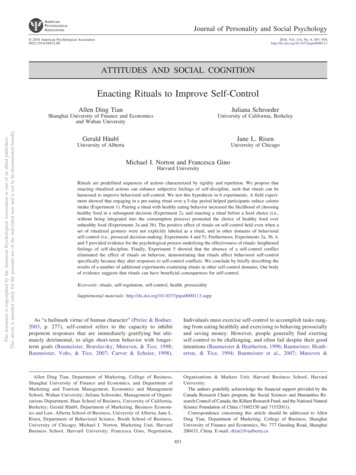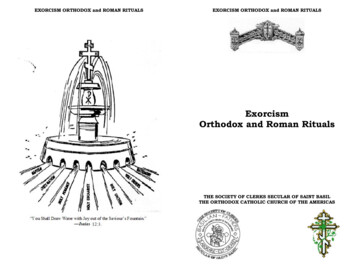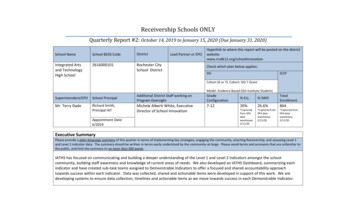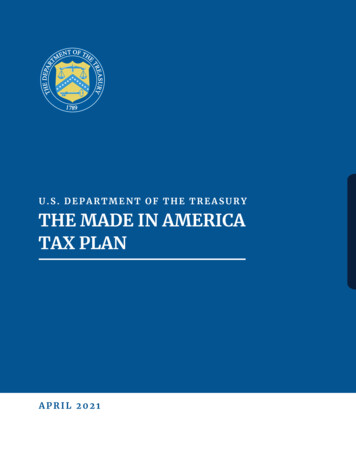
Transcription
Journal of Personality and Social Psychology 2018 American Psychological Association0022-3514/18/ 12.002018, Vol. 114, No. 6, 851– 876http://dx.doi.org/10.1037/pspa0000113ATTITUDES AND SOCIAL COGNITIONThis document is copyrighted by the American Psychological Association or one of its allied publishers.This article is intended solely for the personal use of the individual user and is not to be disseminated broadly.Enacting Rituals to Improve Self-ControlAllen Ding TianJuliana SchroederShanghai University of Finance and Economicsand Wuhan UniversityUniversity of California, BerkeleyGerald HäublJane L. RisenUniversity of AlbertaUniversity of ChicagoMichael I. Norton and Francesca GinoHarvard UniversityRituals are predefined sequences of actions characterized by rigidity and repetition. We propose thatenacting ritualized actions can enhance subjective feelings of self-discipline, such that rituals can beharnessed to improve behavioral self-control. We test this hypothesis in 6 experiments. A field experiment showed that engaging in a pre-eating ritual over a 5-day period helped participants reduce calorieintake (Experiment 1). Pairing a ritual with healthy eating behavior increased the likelihood of choosinghealthy food in a subsequent decision (Experiment 2), and enacting a ritual before a food choice (i.e.,without being integrated into the consumption process) promoted the choice of healthy food overunhealthy food (Experiments 3a and 3b). The positive effect of rituals on self-control held even when aset of ritualized gestures were not explicitly labeled as a ritual, and in other domains of behavioralself-control (i.e., prosocial decision-making; Experiments 4 and 5). Furthermore, Experiments 3a, 3b, 4,and 5 provided evidence for the psychological process underlying the effectiveness of rituals: heightenedfeelings of self-discipline. Finally, Experiment 5 showed that the absence of a self-control conflicteliminated the effect of rituals on behavior, demonstrating that rituals affect behavioral self-controlspecifically because they alter responses to self-control conflicts. We conclude by briefly describing theresults of a number of additional experiments examining rituals in other self-control domains. Our bodyof evidence suggests that rituals can have beneficial consequences for self-control.Keywords: rituals, self-regulation, self-control, health, prosocialitySupplemental materials: http://dx.doi.org/10.1037/pspa0000113.suppAs “a hallmark virtue of human character” (Prelec & Bodner,2003, p. 277), self-control refers to the capacity to inhibitprepotent responses that are immediately gratifying but ultimately detrimental, to align short-term behavior with longerterm goals (Baumeister, Bratslavsky, Muraven, & Tice, 1998;Baumeister, Vohs, & Tice, 2007; Carver & Scheier, 1998).Individuals must exercise self-control to accomplish tasks ranging from eating healthily and exercising to behaving prosociallyand saving money. However, people generally find exertingself-control to be challenging, and often fail despite their goodintentions (Baumeister & Heatherton, 1996; Baumeister, Heatherton, & Tice, 1994; Baumeister et al., 2007; Muraven &Allen Ding Tian, Department of Marketing, College of Business,Shanghai University of Finance and Economics, and Department ofMarketing and Tourism Management, Economics and ManagementSchool, Wuhan University; Juliana Schroeder, Management of Organizations Department, Haas School of Business, University of California,Berkeley; Gerald Häubl, Department of Marketing, Business Economics and Law, Alberta School of Business, University of Alberta; Jane L.Risen, Department of Behavioral Science, Booth School of Business,University of Chicago; Michael I. Norton, Marketing Unit, HarvardBusiness School, Harvard University; Francesca Gino, Negotiation,Organizations & Markets Unit, Harvard Business School, HarvardUniversity.The authors gratefully acknowledge the financial support provided by theCanada Research Chairs program, the Social Sciences and Humanities Research Council of Canada, the Killam Research Fund, and the National NaturalScience Foundation of China (71602150 and 71532011).Correspondence concerning this article should be addressed to AllenDing Tian, Department of Marketing, College of Business, ShanghaiUniversity of Finance and Economics, No. 777 Guoding Road, Shanghai200433, China. E-mail: dtian2@ualberta.ca851
TIAN ET AL.This document is copyrighted by the American Psychological Association or one of its allied publishers.This article is intended solely for the personal use of the individual user and is not to be disseminated broadly.852Baumeister, 2000). Self-control failures have been linked toobesity, smoking, and binge drinking, with economic, health,and social costs for individuals and society (Baumeister, 2002;Baumeister et al., 1994). Interventions that help people toexercise self-control are therefore critical (Patrick & Hagtvedt,2012).We propose a simple yet effective tool to help people exerciseself-control: engaging in rituals. Anecdotal evidence supports thisnotion: popular online blogs suggest that rituals can facilitateself-control, offering “A Simple Ritual That Will Make YourGoals ‘Stick’” (Reynolds, 2011) and describing “The Power ofRitual: Conquer Procrastination, Time Wasters, and Laziness”(Young, 2015). However, research has not empirically tested theeffects of personal rituals on improving self-control. We investigate whether rituals play a causal role in facilitating self-control byrandomly assigning individuals to enact rituals in contexts thatrequire self-control—such as healthy eating and prosocialdecision-making. Moreover, we document a psychological mechanism that at least in part underlies the effectiveness of rituals. Theperformance of rituals— characterized by rigidity and repetition—increases feelings of self-discipline; in turn, this heightened senseof self-discipline drives the effect of rituals on self-control.Theoretical BackgroundRituals are pervasive in everyday life. Religious rites, culturalpractices, group activities, and personal routines often involveritualistic elements. Drawing on previous conceptualizations (Legare & Souza, 2012; Rook, 1985; Tambiah, 1979), we define aritual as a fixed episodic sequence of actions characterized byrigidity and repetition. Although rituals are often viewed as eitherreligious expressions or primitive regressive behavior (Moore &Myerhoff, 1977), rituals in practice take a wide variety of forms,are enacted by individuals and groups in not only religious but alsosecular settings, and are deployed in situations ranging from consuming food to mourning loved ones (Brooks et al., 2016; Browne,1980; Hobson, Schroeder, Risen, Xygalatas, & Inzlicht, 2017;Moore & Myerhoff, 1977; Norton & Gino, 2014; Romanoff, 1998;Rook, 1985; Turner, 1969; Vohs, Wang, Gino, & Norton, 2013).Rituals have been linked to a wide variety of beneficial outcomes. Collective rituals promote social integration and groupsolidarity (Baumeister & Leary, 1995; Durkheim, 1912/1995; Goethals, 1996), facilitate the transmission and reinforcement ofsocial norms (Rossano, 2012), and align individuals’ belief systems with those of society (Davis-Floyd, 1996). Moreover, anemerging stream of research documents the causal impact ofrituals on a variety of intrapersonal psychological and behavioralconsequences, including enhanced consumption experiences(Vohs et al., 2013), mitigated grief over loss (Norton & Gino,2014), and reduced anxiety and improved performance (Brooks etal., 2016).We suggest that rituals can also facilitate the exertion of selfcontrol. A large body of research suggests a general link betweenrituals and control, broadly defined: rituals are perceived as rendering order and stability, particularly in times of chaos (Romanoff, 1998; Turner, 1969), and superstitious rituals are oftenenacted with the purpose of restoring a sense of agency and control(Bleak & Frederick, 1998; Burger & Lynn, 2005; Keinan, 2002;Souza & Legare, 2011). Personal mourning rituals can help indi-viduals regain feelings of control after losses (Norton & Gino,2014), and religious rituals have been linked to increased perceptions of control, including strengthening and instilling willpowerfor the achievement of virtuous goals (Ahler & Tamney, 1964;Anastasi & Newberg, 2008; Hamayon, 2012; Kehoe, 1970; Woods& Lamond, 2011). The reverse link is evident as well: peoplebehave in more rigid and patterned ways after their sense ofcontrol has been diminished (Lang, Krátký, Shaver, Jerotijević, &Xygalatas, 2015; Whitson & Galinsky, 2008).Why might rituals increase self-control? People often infer theirown attitudes, emotions, and other internal states from the observation of their own behavior (Ariely & Norton, 2008; Bem, 1972).This psychological process also applies to rituals: when arbitrarysequences of behaviors lack apparent instrumentality, people adopta ritual stance toward them, imbuing them with meaning (Kapitány & Nielsen, 2015; Legare & Souza, 2012). Relatedly, wepropose that enacting the rigidity and repetition inherent to rituals(Boyer & Liénard, 2006; Rook, 1985; Tambiah, 1979)—and observing oneself do so— can signal self-discipline to the performer.Ainslie (1975) links behavioral rigidity to the exercise of selfcontrol, and, as facets of the overall construct of conscientiousness,traits such as dutifulness (adherence to strict standards) and selfdiscipline (the ability to persist on tasks) have similarly beenlinked to behavioral inhibition and self-control (Costa, McCrae, &Dye, 1991).Further evidence in support of this conjecture comes fromresearch on consumption. Repeated family dinner rituals (e.g.,remaining at the table until everyone has finished eating) arenegatively correlated with family BMI (Body Mass Index;Wansink & Van Kleef, 2014), and successful (albeit unhealthy)efforts to exert excessive self-control over food intake are linked torigid and repetitive pre-eating rituals (Halmi et al., 2000), againsuggesting that rituals might serve a self-regulatory function. Critically, self-discipline has been associated with a range of positiveoutcomes requiring self-control (e.g., academic success; Duckworth & Seligman, 2005, 2006; Waschull, 2005). As a result, wesuggest that enacting rigid, repetitive ritualistic behaviors leads toincreased feelings of self-discipline, and that these subjectivefeelings of self-discipline can in turn increase behavioral selfcontrol.The Present ResearchAlthough prior findings suggest the possibility of a link betweenrituals and self-control, these are primarily correlational in nature.The present research examines whether—and through what mechanism—rituals exert a causal impact on effective self-control. Wepresent evidence from six experiments designed to test our accountthat rituals improve self-control by heightening feelings of selfdiscipline. Moreover, we assess several potential alternative explanations for the efficacy of rituals. Across the experiments, wedesign and utilize rituals characterized by rigidity and repetition tocompare the effect of enacting rituals to performing comparablenonritualized actions— or doing nothing.Experiment 1 is a field experiment designed to test the effect ofrituals on a common self-control problem— eating less—in whichparticipants attempted to reduce their calorie intake over a 5-dayperiod. Experiment 2 examines the effect of ritual engagement ona food choice that posed a self-control dilemma and investigates
This document is copyrighted by the American Psychological Association or one of its allied publishers.This article is intended solely for the personal use of the individual user and is not to be disseminated broadly.ENACTING RITUALS TO IMPROVE SELF-CONTROLwhether the effect is specific to ritualized (as opposed to random)actions. Experiments 3a and 3b distinguish the effect of ritualsfrom habits and provide initial evidence for the psychologicalprocess—feelings of self-discipline—proposed to underlie the effect of rituals on self-control behaviors. These experiments alsoaddress potential alternative mechanisms such as lower decisiondifficulty, greater involvement or enjoyment, and more positiveaffect. Experiments 4 and 5 assess the effect of rituals in anotherself-control context—prosocial decision-making—and providefurther evidence for the mediating role of self-discipline. Experiment 5 also identifies a boundary condition for the effect, namelythat rituals are no longer influential in the absence of a self-controlconflict.Across the studies, we report all variables collected and allconditions included in the study designs. No participants whocompleted our studies were excluded from the analyses unlessotherwise noted for reasons identified before conducting the research.Experiment 1: Weight LossTo test our hypothesis that rituals can improve self-control, wefirst examined the effect of enacting rituals on a pervasive andconsequential self-control problem— unhealthy food consumption—in a longitudinal field setting. Obesity is an increasingconcern in the United States: as of 2014, more than one third(37.7%) of American adults qualified as obese (Flegal, KruszonMoran, Carroll, Fryar, & Ogden, 2016). We recruited undergraduate women at a gym who had the goal to lose weight. Allparticipants received the same instructions to try to reduce theircalorie intake over a 5-day period, but half were told to be“mindful” about their food consumption, whereas the other halfwere taught a pre-eating ritual to remind them to reduce calorieintake. We created the ritual for Experiment 1 to fit our theoreticaldefinition of a ritual: a fixed sequence of behaviors characterizedby repetition and rigidity. The ritual itself did not require participants to eat less food; because it was a pre-eating ritual, it did notdirectly interfere with consumption. We predicted that those whopaired a ritual with food consumption would reduce their calorieintake more that those who were merely mindful.MethodParticipants. Because we did not know what effect size toexpect, we planned to recruit as many participants as possible overthe course of one summer at a gym at a college in the MidwesternUnited States. There were three requirements to participate in thestudy. First, we required participants to be female, both to reducevariance in participants’ daily food intake and because college-agewomen tend to be more concerned with weight-loss goals thancollege-age men (Anderson, Lundgren, Shapiro, & Paulosky,2003). Second, we required participants to have a weight-loss goalto include only individuals who cared about the goal, wouldseriously try to follow our instructions, and would stay in the studyfor all 5 days. Finally, we required participants to own a smartphone so that they would be able to report their daily caloriesthrough a phone application. In total, 93 women (MAge 23.6years, SD 5.2, MWeight 147.6 pounds, SD 25.4, MHeight 65.4 in., SD 2.9) enrolled in the experiment in exchange for a 5853Starbucks gift card immediately upon entry, with the promise ofanother 5 gift card upon completion of all parts of the study.Procedure. We randomly assigned participants to one of twoconditions: ritual or mindful eating (control) condition. Uponagreeing to participate, participants signed a consent form. Wecollected participants’ names, e-mail addresses, and phone numbers on a separate sheet. We explained to participants that wewould call them if we did not receive their survey response by theweek’s end.At enrollment, participants completed Survey 1 in which theyreported the following: their age, estimated body weight (inpounds), estimated height (in feet and inches), and estimatedaverage daily calorie consumption (in kcals). They reported: (a)How likely is it that you will be able to cut your calories by 10%for the next 5 days? (1 not at all likely, 7 very likely); (b) Howimportant to you is your goal to lose weight? (1 not at allimportant, 7 very important); and (c) How happy are you withyour current body image? (1 not at all happy, 7 very happy).Next, participants downloaded an application called “MyFitnessPal” onto their phone. The application allowed participants totrack their daily food and beverage intake, and their exercise.MyFitnessPal allows users to list exactly the type and amount offood or beverage they consumed; the user can search for the exactbrand of a product from the grocery store or a specific mealordered from a chain restaurant. Users have the choice to listindividual foods separately (e.g., breakfast consisted of 1 egg, 1tbs. butter, 1 cup of spinach, and 1 onion), or to use preprogrammed meals that MyFitnessPal or other users have alreadyinputted (i.e., breakfast consisted of 5 oz. of a spinach and onionomelet). We required participants to add the experimenter as a“friend” and set their food diary settings to “Friends only,” therebygiving the experimenter access to their online food diaries. Participants set reminders three times per day that would ring or vibrateto remind them to log their food intake. The experimenter showedparticipants how to complete the food diary. The experimenter alsorecorded participants’ usernames so that we could match their fooddiaries to their data for the rest of the study.Next, participants received the instructions for the study. Allparticipants received these instructions:For the purpose of the study, please try to reduce your typical foodconsumption for the next five days. Try to cut the number of caloriesyou consume by about 10% if you can.1 We will track the number ofcalories you consume and burn for the next five days.In the mindful eating (control) condition, we then told participants, “In order to help you cut your calories, please try to bemindful about what you eat this week. Every time you eat, pleasetry to pause and think carefully about what you are eating.” Wedesigned this condition to control for the amount of attention thatparticipants paid to their eating behaviors.In the ritual condition, we instead told participants,In order to help you to cut your calories, please complete a ritual everytime that you eat in the next five days. This pre-eating ritual has threesteps. First, cut your food into pieces before you eat it. Second,rearrange the pieces so that they are perfectly symmetric on your1We arbitrarily selected 10% to encourage participants to reduce theirfood consumption as drastically as possible.
TIAN ET AL.854This document is copyrighted by the American Psychological Association or one of its allied publishers.This article is intended solely for the personal use of the individual user and is not to be disseminated broadly.plate. That is, get the right half of your plate to look exactly the sameas the left half of your plate. Finally, press your eating utensil againstthe top of your food three times. In order to be in the study, you mustdo the three steps of this ritual each time you eat. The ritual willremind you to reduce your food consumption.To ensure understanding, participants repeated the steps of theritual to the experimenter.All participants received an “instruction” card (see Figures 1and 2) that was the size of a business card. Printed on this cardwere the instructions for their experimental condition.2 Participants then signed a final sheet promising that they would adhere tothe study instructions.After 5 days, we emailed an online survey to participants.Participants first recorded their MyFitnessPal username. Next,they reported: (a) “How happy did you feel with your eating habitsthis past week?” (1 not at all happy, 7 very happy); (b) “Howsuccessful do you think you were in cutting calories by 10% thisweek?” (1 not at all successful, 7 very successful); (3) “Howimportant to you is your goal to lose weight?” (1 not at allimportant, 7 very important); and (d) “How happy are you withyour current body image?” (1 not at all happy, 7 very happy).The survey asked participants whether or not they completed aritual before eating and, if so, to describe the steps of the ritual. Itasked, “How do you think this ritual affected your eating habitsthis week?” (with a blank response box), whether they believed theritual helped them cut calories (1 not at all helpful, 7 veryhelpful), and whether they planned to continue the ritual (1 notat all likely, 7 very likely). The survey asked all participants toestimate their daily average calorie consumption over the past 5days, to estimate their body weight in pounds, and to report “howcarefully you logged your food intake throughout the week (1 not at all carefully, 7 very carefully). Finally, the survey askedparticipants: “If you missed logging any meals, please tell us whatyou missed and why below. (Please be honest; you will not bepenalized at all for your response!)” (with a blank response box).Participants were debriefed on the last page of the survey.ResultsAttrition. Of the 93 participants who originally enrolled (47 incontrol condition, 46 in ritual condition), 85 (91.4%: 45 in controlFigure 1. “Instruction” card in the ritual condition (Experiment 1).Figure 2. “Instruction” card in the control condition (Experiment 1).condition, 40 in ritual condition) completed the final survey andlogged their food intake for at least two full days. Therefore, weremoved eight participants from the sample for not completingenough of the study to analyze. The response rate was not significantly different between conditions, 2 (n 93) 2.28, p .131.Food consumption. We removed any food diaries that wereclearly incomplete. Of the 85 participants, 84 completed the Day 1diary, 81 completed the Day 2 diary, 83 completed Day 3, 76completed Day 4, and 67 completed Day 5 (n 391 total diaries).As such, there was significant attrition across days: fewer participants completed their diary on Day 5 compared with Day 1 inboth the ritual condition (Day 1 40/40, Day 5 33/40) and thecontrol condition (Day 1 44/45, Day 5 34/45), zs 2.77 and3.10, ps .006 and .002. We derived the following data from thefood diaries: the number of calories consumed each day (kcal), thenumber of calories burned (from exercise, kcal), the amount of fatconsumed (g), and the amount of sugar consumed (g).Participants reported consuming fewer calories in the ritualcondition (averaging consumption across all 391 available fooddiaries; M 1424.26, SD 224.92) than in the control condition(M 1648.12, SD 389.27), t(83) 3.19, p .002, d .70, butdid not burn fewer calories (MRitual 270.05, SD 232.77 vs.MControl 234.18, SD 344.34), t(83) 1. Consistent with this,participants in the ritual condition reported consuming less fat andsugar (Ms 50.10 and 53.32, SDs 13.32 and 24.51, respectively) than those in the control condition (Ms 60.12 and 66.61,SDs 20.89 and 28.85, respectively), ts(83) 2.61 and 2.27,ps .011 and .026, ds 0.57 and 0.50. Fat and sugar consumption were positively correlated with the number of calories consumed, rs 0.75 and 0.65, ps .001. These data indicate thatenacting the pre-eating ritual caused participants to report consuming fewer calories, implying that the ritual aided them in exercisingself-control to achieve their weight loss goals.To examine the pattern of consumption across days, we conducted a 5 (days) 2 (experimental condition: ritual vs. control)2Some participants had subsequent questions about how to perform theritual in various cases, such as if they were eating soup, were not using aneating utensil, or were in a social setting. We created scripted responses toeach of these questions in which we told participants that they could revisethe ritual by removing or adjusting a single step but that they must still tryto perform the ritual to the best of their ability.
This document is copyrighted by the American Psychological Association or one of its allied publishers.This article is intended solely for the personal use of the individual user and is not to be disseminated broadly.ENACTING RITUALS TO IMPROVE SELF-CONTROL855Figure 3. Calories consumed and calories burned across each of all 5 days as a function of ritual condition(Experiment 1). Error bars represent SEM.mixed-model analysis of variance (ANOVA) on calories consumed and calories burned (see Figure 3). This analysis onlyincluded participants who completed their food diary for all 5 days(n 33 in control condition, n 30 in ritual condition). Consistent with the results above, there was an effect of experimentalcondition on calories consumed, F(1, 61) 10.02, p .002, p2 0.14, but not on calories burned, F(1, 61) 1. There was no effectof days on calories consumed, F(4, 61) 1, but a marginal effecton calories burned, F(4, 61) 2.01, p .093, p2 0.03; thiseffect on calories burned was not linear, F(1, 61) 1. Finally,there were no interactions, Fs(1, 61) 1.24, ps .270, suggestingno systematic difference in consumption over time between theconditions.Survey responses. As expected given random assignment,there were no differences across conditions in participants’ BMIbefore the study started, their perceived likelihood of cuttingcalories by 10%, their goal importance, or their body imagehappiness, ts 1.42, ps .158. In a linear regression thatcontrolled for age, weight, height, perceived likelihood of cuttingcalories, goal importance, and body image happiness before theexperiment started, experimental condition continued to predictaverage calories consumed, 0.32, p .003 (see Table 1).3By the end of the 5 days, participants in the ritual conditionreported feeling marginally happier with their eating habits andmore successful in meeting their goals (Ms 4.90 and 5.05,SDs 1.34 and 1.55) than those in the control condition (Ms 4.36 and 4.38, SDs 1.40 and 1.47), ts(83) 1.83 and 2.05, ps .071 and .043, ds 0.40 and 0.45, respectively. There were nodifferences by condition for how happy participants were withtheir body image (MRitual 4.53, SD 1.15, MControl 4.27,SD 1.25), how important their goal was to lose weight (MRitual 5.00, SD 1.43, MControl 5.04, SD 1.40) or how carefullythey logged their food intake (MRitual 5.74, SD 0.99,MControl 5.56, SD 1.10), ts 1 (see Figure 4).There was no difference in the change in body image happinessor goal importance from the first to last survey in the ritualcondition (Ms 0.05 and 0.30, SDs 1.08 and 1.32) comparedwith the control condition (Ms 0.27 and 0.00, SDs 0.81 and1.19), ts(83) 1.10 and 1.05, ps .274 (see Figure 4). However,body image happiness significantly decreased in the control con3In this regression, age and body image also marginally positivelypredicted number of calories consumed, s 0.19 and 0.20, ps .073 and.062, respectively. Surprisingly, body weight did not predict calories consumed, but we note that weight and height were self-reported and, therefore, these measures are subject to social desirability concerns. We examined the raw correlations between these presurvey variables and caloriesconsumed: age, weight, and height were positively correlated with caloriesconsumed, rs 0.22, 0.20, and 0.27, ps .049, .061, and .014, respectively, but the other presurvey measures did not correlate with caloriesconsumed. We also examined whether any presurvey measures correlatedwith calories burned: only the perceived likelihood of cutting caloriescorrelated with number of calories actually burned, r 0.23, p .034.
TIAN ET AL.856Table 1Results of Regression Analysis on Average Calories Consumed Over 5 Days (Experiment 1)PredictorbSE tpAgeWeightHeightPerceived likelihood of cutting caloriesGoal importanceBody image happinessRitual (0 control, 1 ritual)12.421.7011.84 7.95 24.0263.89 213.616.831.8215.3024.1427.7533.6869.52.19.12.10 .04 .10.20 .321.82.93.77 .33 .871.90 3.07.073.354.441.743.389.062.003This document is copyrighted by the American Psychological Association or one of its allied publishers.This article is intended solely for the personal use of the individual user and is not to be disseminated broadly.Note.Dependent variable: Average calories consumed over 5 days.dition, one-sample t test compared with 0: t(44) 2.21, p .032, but not in the ritual condition, one-sample t(39) 0.29,p .772, suggesting rituals may provide at least some bufferagainst unhappiness.Finally, we examined beliefs about the ritual from the participants in the ritual condition; 100% of these participants correctlyrecalled the three steps of the ritual. Despite the effectiveness ofrituals, participants tended to think the ritual was not very helpful(M 2.84, SD 1.39), significantly less than 4 on the 7-pointscale, t(37) 5.31, p .001, and reported being unlikely tocontinue it (M 1.70, SD 1.20).DiscussionExperiment 1 provides initial evidence for our proposition thatrituals boost self-control. Participants who enacted a pre-eatingritual reported significantly lower calorie consumption than thosewho attempted to be mindful about what they ate, indicating thatthe effect of ritual on self-control goes above and beyond the effectof mindfulness about one’s behavior. Results also suggest that theeffect of rituals on calorie consumption is not driven by changes inperceived goal importance or happiness with body image.Of course, there are several alternative explanations for why thepre-eating ritual reduced food consumption in this study. Forinstance, enacting pre-eating rituals may have been embarrassing,leading participants to eat less socially, or may have been arduous,making the eating experience less enjoyable. The ritual may alsohave made the food seem less appealing; cutting food into littlepieces and rearranging it on the plate might reduce the positive,tempting, palatable appearance of food. Moreover, it is also possible that participants who were tol
self-control, offering “A Simple Ritual That Will Make Your Goals ‘Stick’” (Reynolds, 2011) and describing “The Power of Ritual: Conquer Procrastination, Time Wasters, and Laziness” (Young, 2015). However, research has not empirically tested the effects of personal ritual










